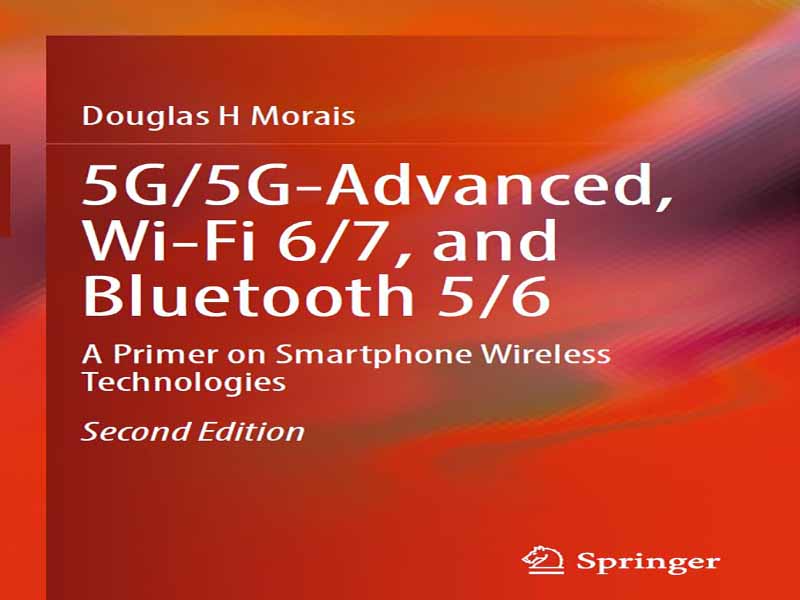- عنوان کتاب: 5G/5G-Advanced, Wi-Fi 67, and Bluetooth 56, 2nd
- نویسنده: Douglas H Morais
- حوزه: ارتباطات بیسیم
- سال انتشار: 2025
- تعداد صفحه: 222
- زبان اصلی: انگلیسی
- نوع فایل: pdf
- حجم فایل: 9.73 مگابایت
این ویرایش دوم، بهروزرسانی ویرایش اول این متن است. مطالب موجود در ویرایش اول، عمدتاً به 5G مطابق تعریف در نسخههای 15 و 16 استاندارد 3GPP، وایفای مطابق نسخه 6 و بلوتوث مطابق نسخه 5 میپرداخت. این ویرایش با گنجاندن مطالب مرتبط از نسخههای 17 و 18 استاندارد 3GPP (5G-Advanced)، وایفای 7 و بلوتوث 6، به مجموعه اطلاعات ارائه شده قبلی میافزاید. ارتباطات بیسیم در دنیای امروز متنوع و فراگیر است. با این حال، میتوان گفت بزرگترین و قابل مشاهدهترین بخش آن، شبکههای تلفن همراه است. ارتباط بین یک واحد تلفن همراه و یک ایستگاه پایه شبکه تلفن همراه معمولاً به عنوان دسترسی سیار شناخته میشود و امروزه اکثر واحدهای تلفن همراه به اصطلاح تلفنهای هوشمند هستند. با این حال، یک تلفن هوشمند چیزی فراتر از یک تلفن است. این یک دستگاه رایانهای قابل حمل است که ارتباطات تلفن همراه را با مجموعهای از عملکردهای محاسباتی ترکیب میکند. علاوه بر این، علاوه بر دسترسی سیار، فناوریهای ارتباط بیسیم Wi-Fi، بلوتوث و ناوبری GPS را نیز در خود جای داده است. با گنجاندن وایفای، این فناوری، به ویژه در محیطهای داخلی، از دسترسی به اینترنت پرسرعت، مستقل از دسترسی پرهزینه و کند موبایل، بهره میبرد. این امر میتواند در مکانهای پرجمعیت مانند فرودگاهها، مراکز خرید، ورزشگاهها و غیره بسیار مفید باشد. علاوه بر این، به تلفن هوشمند اجازه میدهد تا به عنوان یک “نقطه اتصال” عمل کند و به فرد امکان اتصال دستگاههایی مانند لپتاپ و تبلت را از طریق تلفن هوشمند به اینترنت بدهد. با گنجاندن بلوتوث، امکان ارتباط بیسیم با برد بسیار کوتاه بین تلفن هوشمند و طیف وسیعی از دستگاهها مانند بلندگوها، هدفونها، سمعکها و ساعتهای هوشمند را فراهم میکند. با گنجاندن ناوبری GPS، امکان مکانیابی دقیق دستگاه را فراهم میکند. هدف این متن، انتقال فناوریهای کلیدی پشت آخرین نسخههای ارزیابی تلفن همراه، وایفای و ارتباط بیسیم بلوتوث در سطح بالا و به شیوهای قابل فهم است که این نسخهها به ترتیب 5G/5G-Advanced، Wi-Fi 6/7 و Bluetooth 5/6 هستند. در حال حاضر متونی وجود دارند که به صورت جداگانه بر روی یکی از سه سیستم ارتباطی پوشش داده شده در اینجا تمرکز دارند. با این حال، تا جایی که نویسنده میتواند مشخص کند، هیچ یک از این کتابها به طور کامل به هر سه سیستم نپرداختهاند. به طور کلی، اکثر این سیستمها را در سطحی پوشش میدهند که فرض را بر این میگذارد که خواننده از قبل تا حدودی با آنها آشنا است و به دنبال درک عمیقتری از آنها میباشد. از سوی دیگر، این کتاب تنها پیشینه فنی محدودی در مخابرات و احتمالاً عدم آگاهی از برخی یا همه فناوریهای خاص تحت پوشش را پیشفرض قرار میدهد. مطالب ارائه شده در اینجا، پس از یک مقدمه کوتاه، با توضیحی در مورد فناوریهای کلیدی به کار رفته در سیستمهای ارتباطی مورد مطالعه آغاز میشود، سپس به طور جداگانه به چگونگی استفاده هر یک از این سیستمها از این فناوریها برای ایجاد یک سیستم کارآمد میپردازد. این کتاب برای متخصصان صنعت، دانشگاهیان و عموم مردم با تمایل به کسب اطلاعات بیشتر در مورد ارتباطات بیسیم گوشیهای هوشمند تهیه شده است. این کتاب عمداً از نظر ریاضی دقیق نیست تا برای مخاطبان گسترده مناسب باشد. خوانندهای که با فناوریهای منفرد پوشش داده شده در فصلهای قبلی و سیستمهای هدفمند پوشش داده شده در فصلهای بعدی نسبتاً آشنا است، میتواند مستقیماً به فصلهای بعدی، یعنی فصلها، مراجعه کند. ۸، ۹ و ۱۰. در هر یک از این فصلها، جایی که به یک فناوری خاص اشاره شده است، به بخشی از فصل قبل که در آن فناوری خاص شرح داده شده است، ارجاع داده شده است. بنابراین، در صورت نیاز به بهروزرسانی دانش فرد در مورد یک فناوری خاص، محل شرح آن به راحتی در دسترس است. برای کسانی که مایل به بررسی برخی یا تمام مطالب ارائه شده با جزئیات بیشتر هستند، چندین مرجع ارائه شده است. علاوه بر این، در حال حاضر تعدادی متن وجود دارد و بدون شک تعداد بیشتری منتشر خواهد شد که به طور کلی به فناوریهای ارائه شده در اینجا با جزئیات بیشتر میپردازند. هدف این متن این است که به خواننده، در صورت تمایل، اجازه دهد تا با اطمینان خاطر با این کتابهای پیشرفتهتر برخورد کند.
This second edition is an update to the first edition of this text. Material in the first edition addressed 5G primarily as defined in 3GPP Releases 15 and 16, Wi-Fi as per Version 6, and Bluetooth as per Version 5. This edition adds to the body of information previously presented by including relevant material from 3GPP Releases 17 and 18 (5G-Advanced), Wi-Fi 7, and Bluetooth 6. Wireless communications in today’s world is diverse and ubiquitous. However, its largest and most visible segment is arguably cellular mobile networks. Communication between a mobile unit and a cellular network base station is commonly referred to as mobile access, and today most mobile units are so-called smartphones. A smartphone is much more than a phone, however. It’s a portable computer device that combines mobile telephone communications with a host of computing functions. Further, in addition to mobile access, it incorporates Wi-Fi, Bluetooth, and GPS navigation wireless communication technologies. By including Wi-Fi, it avails itself, particularly in indoor environments, of high-speed Internet access independent of what can at times be costly and slow mobile access. This can be very helpful in high-density locations such as airports, shopping malls, sporting arenas, etc. Further, it allows the smartphone to act as a “hotspot,” allowing one to connect devices such as laptops and tablets to the Internet via the smartphone. By including Bluetooth, it allows very short-range wireless communication between the smartphone and a range of devices such as speakers, headphones, hearing aids, and smartwatches. By including GPS navigation, it allows precise device location. It is the aim of this text to convey at a high level, and in a tractable fashion, the key technologies behind the latest versions of mobile assess, Wi-Fi, and Bluetooth wireless communication, these versions being 5G/5G-Advanced, Wi-Fi 6/7, and Bluetooth 5/6, respectively. Texts already exist that individually focus on one of the three communication systems covered herein. No single one, however, as best the author can ascertain, addresses at a high level all three systems. Most, in general, cover these systems at a level that presupposes that the reader is already somewhat familiar with them and seeks a deeper understanding. This book, on the other hand, presupposes only a limited technical background in telecommunications and possibly no knowledge of some or all of the specific technologies covered. The material presented herein commences, after a brief introduction, with an explanation of the key technologies employed by the communication systems under study, then addresses individually how each such system employs these technologies to create a working system. It is directed to industry professionals, academics, and members of the general public with a desire to learn more about smartphone wireless communications. It is intentionally not mathematically rigorous so as to be friendly to a wide audience. The reader who is fairly familiar with the individual technologies covered in the earlier chapters and incorporated into the targeted systems covered in later chapters may choose to go directly to those later chapters, namely Chaps. 8, 9, and 10. In each of these chapters, where a specific covered technology is mentioned, reference is made to the section in a preceding chapter where the specific technology is described. Thus, should the need arise to refresh one’s knowledge on a given technology, the location of its description is readily available. For those desiring to explore some or all of the material presented in greater detail, several references are provided. Further, a number of texts currently exist, and more will no doubt continue to be released, that collectively treat the technologies presented here in greater detail. A goal of this text is to allow the reader, if he or she so desires, to tackle these more advanced books with confidence.
این کتاب را میتوانید از لینک زیر بصورت رایگان دانلود کنید:




































نظرات کاربران